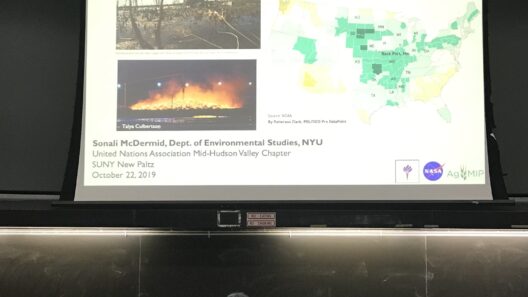The quest to comprehend Earth’s climate has been a transformative journey, navigating through the realms of philosophy, mathematics, and physics. At the heart of this journey lies the monumental contributions of Joseph Fourier, a French mathematician and physicist, whose work laid the foundational stones for climate science and the concept of global warming. Understanding Fourier’s contributions is not merely a nostalgic glance into history; it is a clarion call for contemporary society to reflect on its stewardship of the planet.
Born in 1768, Fourier’s early life in Auxerre, France, was characterized by a thirst for knowledge. He embarked on a path of academic prowess, ultimately earning prestigious positions, including that of a professor at the École Polytechnique. Here, he began to unravel the intricate tapestry of heat transfer, a fundamental aspect of understanding climate dynamics.
Fourier’s 1824 treatise, “Théorie analytique de la chaleur” (Analytical Theory of Heat), marks a watershed moment in scientific inquiry. In this work, Fourier introduced a groundbreaking concept known as the greenhouse effect. He posited that the Earth’s atmosphere acts as a thermal blanket, absorbing and redistributing solar radiation. This was a pivotal assertion. Before Fourier’s revelations, the foundational understanding of heat transfer was rudimentary at best. His pioneering mathematical techniques slightly complicated the existing knowledge regarding heat conduction, showcasing how energy moves through various media.
At its core, Fourier’s theory illuminated the interplay between solar energy and the Earth’s surface. He argued that the atmosphere plays a crucial role in moderating temperatures, averting extreme conditions by trapping a fraction of outgoing heat. This phenomenon, akin to glass panes in a greenhouse, explains how the atmosphere can sustain life by creating a temperate biosphere. Fourier’s meticulous exploration of this concept signified not just an academic achievement but a fundamental rethinking of how humankind relates to the planet.
The decade following the release of Fourier’s thesis marked a period wherein the scientific community began to scrutinize the implications of his findings. His ideas were foundational in geology, meteorology, and eventually climatology. Practical demonstrations of the greenhouse effect had been observed, but Fourier’s work provided the mathematical framework necessary for broader acceptance and understanding of this essential principle. His work resonated through generations, inspiring scientists such as John Tyndall, who later elucidated the role of specific gases, like carbon dioxide and methane, in enhancing the greenhouse effect.
But why did Fourier’s work gain traction? The early 19th century was a fertile ground for scientific exploration, characterized by the Industrial Revolution. Exciting developments in industry and technology simultaneously raised awareness about environmental impacts. As humanity began to harness fossil fuels at an unprecedented scale, the resonance of Fourier’s theories became apparent. The burning of coal and oil released greenhouse gases at an alarming rate, invoking questions regarding global atmospheric changes.
With each decade that followed, the ominous specter of climate change began to loom more significant in the public consciousness. The mathematical principles laid out by Fourier became vital tools for scientists addressing this burgeoning crisis. As civilization thrived on industrial advancement, Fourier’s legacy increasingly underscored an urgent discourse surrounding sustainability. The remarkable aspect was how Fourier’s mathematical elegance juxtaposed sharply with the brute force of industrial progression. The ongoing conflict illustrated a critical dichotomy: human ingenuity can illuminate pathways to understanding phenomena like global warming while simultaneously exacerbating the challenges associated with it.
Over the years, Fourier’s work has been revisited, reevaluated, and expanded upon to accommodate evolving models of climate prediction. Advanced computational techniques provide increasingly sophisticated insights into the earth’s climatic systems. Today, Fourier’s influence persists in contemporary climate models that simulate potential outcomes of various greenhouse gas emission scenarios. The deeply embedded influence of Fourier’s analytical methodologies within these models attests to the timelessness of his contributions.
For modern environmentalists, Fourier’s insights serve as both a warning and a promise—a warning about the ramifications of unrestrained consumption and a promise for our ability to change course. The greenhouse gases that modern civilization liberally emits are now a primary driver of global warming, validating Fourier’s original hypotheses even further. In a world where the climate is in flux, revisiting Fourier’s findings invites a transformational dialogue about carbon footprints, renewable energy, and the future of humanity’s ecological footprint on Earth.
The interplay between Fourier’s work and present-day climate science challenges us to reflect inwardly. How do we, as stewards of this planet, grapple with the knowledge that our actions impact its delicate balance? Fourier’s legacy encourages us to transcend apathy, urging a collective shift towards innovation, resilience, and sustainability. By embracing the implications of Fourier’s insights, we can cultivate an informed and engaged populace capable of addressing one of humanity’s most pressing challenges.
In summary, Joseph Fourier’s ambitious inquiry into heat transfer not only spearheaded the scientific dialogue on global warming but also underscored our profound interconnectedness with the natural world. The synthesis of his mathematical rigor and philosophical inquiry continues to inspire tomorrow’s climate scientists and advocates. Equally, it serves as an admonition – reminding us that the relationship we cultivate with our planet is one that will define future generations. Fourier’s narrative of curiosity and caution beckons a renewed commitment to climate science, rooted in an understanding that our actions today shape the environmental legacy we leave behind.







